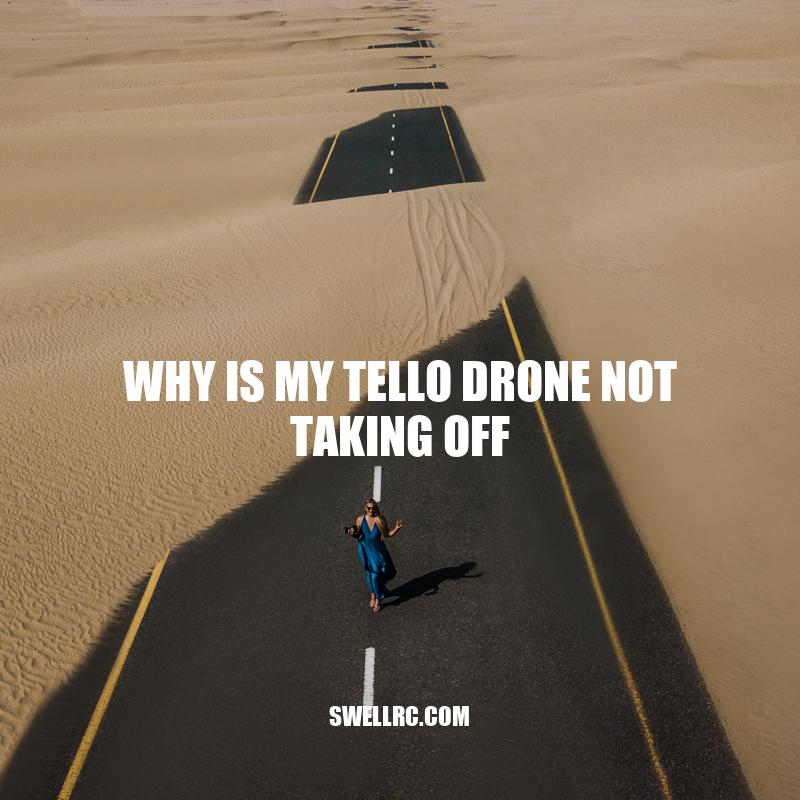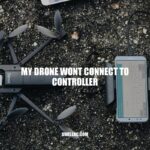Why Tello Drone Not Taking Off: Troubleshooting Tips
The excitement of getting a new Tello drone can quickly turn into frustration if it doesn’t take off. Whether you’re a beginner or an experienced drone pilot, there can be several reasons why your Tello drone is not taking off. Without proper troubleshooting, you may not be able to fly and enjoy your drone. A Tello drone is one of the most popular drones on the market due to its affordability, small size, and simplicity for beginners. Tello drones are user-friendly and equipped with features that make flying enjoyable. However, like any other drone, Tello drones can also encounter issues and malfunctions. As frustrating as it can be to see your drone not taking off, there are several things you can do to troubleshoot the issue. In this article, we will explore some of the common reasons why a Tello drone may not take off and offer tips on how to fix the issue.
Battery Issues
If your Tello drone is not taking off, one of the most common reasons is related to battery issues. Here are some things to check:
- Make sure the battery is fully charged
- Check that the battery is securely inserted into the drone
- If the battery is fully charged and inserted correctly, try resetting the drone and recalibrating it before attempting to take off again
If you need to purchase a new battery, you can find official Tello drone batteries on the DJI store or other retailers like Amazon.
It’s also important to note that the battery life of a Tello drone is approximately 13 minutes. Make sure to check the amount of battery life left before attempting a takeoff.
How long can the Tello drone fly?
According to DJI, the manufacturer of Tello, the drone has a maximum flight time of approximately 13 minutes on a fully charged battery. However, this may vary depending on various factors such as battery health, flying conditions, and flying style. It is recommended to always fly your Tello in open areas with good GPS signal strength for optimum flying time. A spare battery can also be purchased separately to extend the drone’s flight time.
For more information about Tello drone and its specifications, you can visit the official DJI website at https://www.dji.com/tello.
Obstacle Avoidance
If your Tello drone is not taking off, it could be due to its obstacle avoidance sensors detecting potential collisions. Here are some precautions to consider:
- Check the surrounding area for possible obstacles in the immediate flight path
- Use the Tello app if you are skeptical about the area. The app informs you if there are obstacles in the surrounding area that will affect your drone.
- Ensure that you are flying within a 30m radius of the device you are using to control the drone
- Place barriers or cautionary tape around the surface and remove dangling objects
| Pros of Tello Drone’s Obstacle Avoidance: | Cons: |
|---|---|
| Hinders potential collisions and landing failure | Obstacle avoidance will activate well before an actual collision, in tight spaces this can lead to a slow takeoff and landing |
| Helps pilots moving near objects or landmarks | Obstacle avoidance can be confused by dark textures and colors, especially in the open and bright spaces |
| Handy feature for indoor flights | Obstacle avoidance can detect objects that are farther away causing the Tello drone to remain grounded |
It is noteworthy to mention that the obstacle avoidance feature is not unique, but it is essential for safe flight operation.
For more information on the Tello drone, visit the Ryze Robotics website.
Can you add obstacle avoidance to a drone?
Yes, obstacle avoidance technology can be added to a drone. Many drone manufacturers offer obstacle avoidance sensors or modules as an add-on feature that can be installed on a compatible drone.
Some popular drone models with obstacle avoidance technology built-in or available as as an add-on are:
- DJI Mavic 2 Pro
- Parrot Anafi
- Yuneec Typhoon H Plus
These drones use technology such as lidar, infrared sensors, and cameras to prevent collisions with obstacles. Additionally, some drones also have intelligent flight modes that allow them to avoid obstacles while flying, such as DJI’s ActiveTrack and QuickShot modes.
If you’re interested in adding obstacle avoidance to a drone, make sure to research and choose a compatible sensor or module for your drone model.
Indoor vs. Outdoor Flights
Your Tello drone is equipped to fly indoors and outdoors, but you must consider the environment before you take off. Here are some things to consider:
- When flying indoors, make sure to have a clear space free from obstacles that could obstruct your drone’s path
- Ensure the lighting is sufficient, and the drone is connected to Wi-Fi before starting to fly
- When flying outdoors, check the weather forecast beforehand and avoid flying in extreme conditions
- Find an open area that is free from obstacles to fly your drone
- Be aware of flying limitations in controlled airspace and follow government rules and regulations.
Before attempting to take a flight, go through the Tello app manual and resolve all instructions that are not clear.
Tello drones are reasonably priced and cater to beginners, hence making it good enough for educational purposes. Its primary specialty is its fun and engaging profile, allowing the user to achieve optimal control within the first few hours of practice. In addition, the company offers spare batteries and protects guards as a separate purchase.
Can you fly the Tello drone outside?
Yes, the Tello drone can be flown outdoors. However, it is important to keep in mind that certain weather conditions such as strong winds or rain may affect its ability to fly properly.
Here are some tips for flying the Tello drone outdoors:
- Choose an open area with plenty of space and few obstacles.
- Avoid flying in windy or rainy conditions as it may affect the stability of the drone.
- Ensure that the drone has a clear line of sight throughout the flight.
- Be aware of any local regulations or restrictions on flying drones in your area.
For more information about the Tello drone, visit the official product page on the DJI website.
Motor Issues
Another reason your Tello drone may not take off is due to motor issues that prevent it from functioning correctly. If one or more motors are damaged or not working, it can cause your drone to lose balance, resulting in the drone’s inability to take off. Here are some troubleshooting tips:
- Examine the drone’s motors for signs of damage or wear and tear
- If you discover that the motors are damaged, contact the manufacturer or a professional drone repair service for assistance
- Consider purchasing replacement motors to solve the problem quickly and easily.
It is important to note that attempting to repair your Tello drone yourself could result in further damage. To avoid making the problem worse, it is best to seek assistance from the manufacturer or a professional drone repair service.
When buying replacement motors or any other Tello accessories, ensure that they are made explicitly for Tello drones by purchasing them from authorized dealers such as DJI or directly from the manufacturer’s website. This ensures that you don’t end up damaging your drone due to incompatible components.
Why is my Tello Edu drone not taking off?
Possible reasons why your Tello Edu drone is not taking off are:
- The batteries may be low or not properly charged.
- The propellers may be damaged or not installed correctly.
- The drone may not be connected to the remote controller or the mobile device properly.
- The environment may not be suitable for the drone to take off, such as too windy or too confined.
- The firmware version of the drone, app, and remote controller may not be updated or compatible.
To troubleshoot your Tello Edu drone, you can consult the official support page of DJI, the manufacturer of the drone, or visit the Tello Edu community forum where other users and experts share tips and solutions. Make sure to follow the safety guidelines and regulations when flying your drone.
Safety Precautions
Flying a drone takes practice and patience, and it is important to follow all safety precautions when operating your Tello drone. Here are some tips for flying your drone safely:
- Fly your drone in open areas away from people, buildings, trees, and other obstructions
- Do not fly over people, as this could put them at risk of injury
- Keep your drone within your line of sight at all times
- Check the weather conditions before flying your drone and avoid flying in windy or rainy conditions
- Follow all drone flying regulations and laws in your area to avoid getting in trouble with authorities
It is also essential to ensure that your Tello drone is functioning correctly and to check that it is not damaged or malfunctioning before flying. To avoid accidents and crashes, ensure that you are familiar with your drone’s capabilities and functions, including its maximum altitude, battery life, obstacle avoidance, and return-to-home features.
You can learn more about drone safety by visiting websites such as the Federal Aviation Administration or the Academy of Model Aeronautics. By staying informed and following safety guidelines, you can minimize the risk and maximize the fun of flying your Tello drone.
How do I operate my Tello drone?
To operate your Tello drone, follow these steps:
- Download the Tello app on your smartphone (available on both Apple and Android devices)
- Connect your smartphone to the Tello’s Wi-Fi network
- Calibrate the drone before its first flight using the app
- Use the app to control the Tello’s movements and capture photos and videos
- When finished, use the app to land the drone safely
For more detailed instructions and troubleshooting tips, visit the official Tello website or consult the user manual that comes with the drone.
Conclusion
In conclusion, troubleshooting a Tello drone that will not take off can be challenging, but it is important to remain calm and focused. By following the tips outlined in this article, you can troubleshoot most issues and get your drone off the ground safely.
Remember that every drone is different and may require unique solutions to overcome problems. Don’t hesitate to contact the manufacturer or seek assistance from a professional if you are unsure about troubleshooting issues or if your drone requires repair or replacement.
With practice and patience, you can become a skilled drone operator and enjoy the thrill of flying your Tello drone. Whether you are using it for aerial photography, videography or simply as a recreational activity, flying a drone can be enjoyable and fulfilling.
So, keep these tips in mind and fly your Tello drone with caution, responsibility, and respect for others and the environment.



